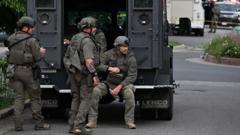Ukraine's recent drone attacks reveal significant developments in its ongoing conflict with Russia, with implications on military strategy and morale.
Ukraine Executes Major Drone Strike on Russian Air Bases: Key Insights

Ukraine Executes Major Drone Strike on Russian Air Bases: Key Insights
A coordinated drone offensive targets key military airfields across Russia, striking a blow to Moscow's air power.
In a stunning escalation of its military operations, Ukraine has successfully executed one of its most extensive aerial assaults, deploying a total of 117 drones that struck airfields across various regions of Russia, from Siberia to its western borders. This surprising maneuver has set several Russian military aircraft ablaze and has sent shockwaves through the Kremlin, delivering a notable blow to Moscow’s ongoing air campaign in Ukraine.
Russian military spokespersons reported that no casualties occurred from these drone strikes while claiming that they repelled additional Ukrainian attempts. However, the sheer scale of the drone attack, which spanned five time zones and included airfields in locations as diverse as Murmansk near Norway and Irkutsk in Siberia, signals a bold and audacious move by Ukraine.
The Ukrainian Security Services (S.B.U.) shared that dozens of Russian aircraft sustained damage during the attack, marking it as a significant intelligence operation that blindsided Russian defenses. Reports indicate that Russian authorities apprehended some participants linked to what they denounced as “terrorist attacks.”
This operation is not just an immediate tactical strike; it carries strategic significance in the broader context of the Russia-Ukraine war. Analysts suggest that Ukraine aims to undermine Moscow's air power and escalate the pressure on Russian military capabilities, while also boosting the morale of its own forces and supporters domestically and internationally.
The consequences of this drone strike could have lasting implications for the ongoing conflict, as both nations assess the balance of power and strategize their next moves in this protracted confrontation.
Russian military spokespersons reported that no casualties occurred from these drone strikes while claiming that they repelled additional Ukrainian attempts. However, the sheer scale of the drone attack, which spanned five time zones and included airfields in locations as diverse as Murmansk near Norway and Irkutsk in Siberia, signals a bold and audacious move by Ukraine.
The Ukrainian Security Services (S.B.U.) shared that dozens of Russian aircraft sustained damage during the attack, marking it as a significant intelligence operation that blindsided Russian defenses. Reports indicate that Russian authorities apprehended some participants linked to what they denounced as “terrorist attacks.”
This operation is not just an immediate tactical strike; it carries strategic significance in the broader context of the Russia-Ukraine war. Analysts suggest that Ukraine aims to undermine Moscow's air power and escalate the pressure on Russian military capabilities, while also boosting the morale of its own forces and supporters domestically and internationally.
The consequences of this drone strike could have lasting implications for the ongoing conflict, as both nations assess the balance of power and strategize their next moves in this protracted confrontation.





















